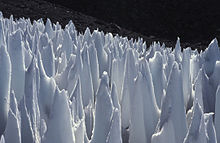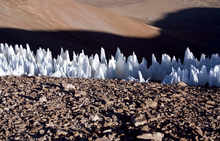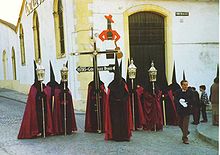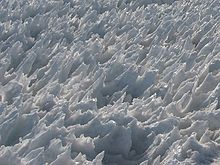- Penitentes
-
For the Argentine ski resort, see Los Penitentes.For the New Mexico confraternity, please see Penitentes (New Mexico). Or see penitent.
 Field of Penitentes (1.5-2m high); upper Rio Blanco, Central Andes of Argentina.
Field of Penitentes (1.5-2m high); upper Rio Blanco, Central Andes of Argentina. Small penitentes in the summit crater of Mount Rainier.
Small penitentes in the summit crater of Mount Rainier.
 Penitentes ice formations at the southern end of the Chajnantor plain in Chile.
Penitentes ice formations at the southern end of the Chajnantor plain in Chile.
Penitentes, or nieves penitentes ("penitente-shaped snows", in Spanish), are a snow formation found at high altitudes. They take the form of tall thin blades of hardened snow or ice closely spaced with the blades oriented towards the general direction of the sun. Penitentes can be as tall as a person.
These pinnacles of snow or ice grow over all glaciated and snow covered areas in the Dry Andes above 4,000 m (Lliboutry 1954a, Lliboutry 1954b, Lliboutry 1965). They range in size from a few cm to over five metres. (Lliboutry 1965, Naruse and Leiva 1997).
Contents
First description
Penitentes were first described in the literature by Darwin in 1839. On March 22, 1835, he had to squeeze his way through snowfields covered in penitentes near the Piuquenes Pass, on the way from Santiago de Chile to the Argentinian city of Mendoza, and reported the local belief (continuing to the present day) that they were formed by the strong winds of the Andes.
Formation
Lliboutry noted that the key climatic condition for the differential ablation that leads to the formation of penitentes is that dew point is always below freezing. Thus, snow will sublimate, because sublimation requires a higher energy input than melting. Once the process of differential ablation starts, the surface geometry of the evolving penitente produces a positive feedback mechanism, and radiation is trapped by multiple reflections between the walls. The hollows become almost a black body for radiation, while decreased wind leads to air saturation, increasing dew point temperature and the onset of melting. In this way peaks, where mass loss is only due to sublimation, will remain, as well as the steep walls, which intercept only a minimum of solar radiation. In the troughs ablation is enhanced, leading to a downward growth of penitentes. A mathematical model of the process has been developed by Betterton (2001), although the physical processes at the initial stage of penitente growth, from granular snow to micropenitentes, still remain unclear. The effect of penitentes on the energy balance of the snow surface, and therefore their effect on snow melt and water resources have been described by Corripio (2003) and Corripio and Purves (2005).
Further reading
- Betterton, M. D.: 2001, Theory of structure formation in snowfields motivated by penitentes, suncups, and dirt cones, Physical Review E 63(056129), 12 pages. http://prola.aps.org/
- Vance Bergeron, Charles Berger, and M. D. Betterton, 2006. Controlled Irradiative Formation of Penitentes, PRL 96, 098502 (2006) http://arxiv.org/pdf/physics/0601184
- Corripio, J. G.: 2003 Modelling the energy balance of high altitude glacierised basins in the Central Andes. PhD thesis University of Edinburgh. http://www.ihw.ethz.ch/staff/jcorripi/corripiophd.pdf
- Corripio, J. G. and Purves, R. S.: 2005, Surface Energy Balance of High Altitude Glaciers in the Central Andes: the Effect of Snow Penitentes, in C. de Jong, D. Collins, and R. Ranzi (eds), Climate and Hydrology in Mountain Areas, Wiley & Sons, London. http://www.ihw.ethz.ch/staff/jcorripi/corripiopurves04.pdf
- Darwin, C.: 1839, Journal of researches into the geology and natural history of the various countries visited by H. M. S. Beagle, under the command of Captain Fitz Roy, R.N., 1832 to 1836, H. Colburn, London.
- Kotlyakov, V. M. and Lebedeva, I. M.: 1974, Nieve and ice penitentes, their way of formation and indicative significance, Zeitschrift für Gletscherkunde und Glazialgeologie Bd X, 111-127.
- Lliboutry, L.: 1954a, Le Massif du Nevado Juncal ses penitentes et ses glaciers, Revue de Géographie Alpine 42, 465-495.
- Lliboutry, L.: 1954b, The origin of penitentes, Journal of Glaciology 2(15), 331-338.
- Lliboutry, L.: 1965, Traité de Glaciologie, Vol. I & II, Masson, Paris.
- Lliboutry, L.: 1998, Glaciers of the Dry Andes, in R. S. J. Williams and J. G. Ferrigno (eds), Satellite Image Atlas of Glaciers of the World SOUTH AMERICA, United States Geological Survey Professional Paper 1386-I. http://pubs.usgs.gov/prof/p1386i/index.html
- Naruse, R. and Leiva, J. C.: 1997, Preliminary study on the shape of snow penitents at Piloto Glacier, the Central Andes, Bulletin of Glacier Research 15, 99-104.
Glaciers Types of glaciers - Cirque glacier
- Ice cap
- Ice field
- Ice sheet
- Ice shelf
- Ice stream
- Outlet glaciers
- Rock glaciers
- Valley glaciers
- Ledoyom (Ice body)
Anatomy Processes Measurements Glaciovolcanic relations Glacial landforms Erosional- Arête
- Cirque
- Crag and tail
- Fjord
- Glacial horn
- Glacial striae
- Hanging valley
- Ribbon lake
- Roche moutonnée
- Tunnel valley
- U-valley
Depositional- Drumlin
- Drumlin field
- Erratic block
- Moraine
- Pulju moraine
- Rogen moraine
- Terminal moraine
- Till plain
- Veiki moraine
Glacifluvial- Esker
- Kame
- Kame delta
- Kettle hole
- Outwash fan
- Sandur
- Giant current ripples
- Diluvium
- Glaciology
- Category:Glaciers
External links
- Spiky glaciers are slower to melt, New Scientist (March 7, 2007)
Categories:- Glaciology
- Snow or ice weather phenomena
Wikimedia Foundation. 2010.


